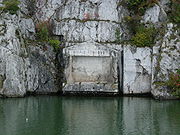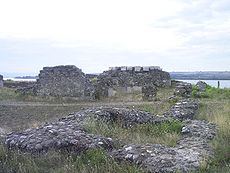
Trajan's bridge
Encyclopedia
Trajan's Bridge or Bridge of Apollodorus over the Danube was a Roman segmental arch bridge, the first to be built over the lower Danube
. For more than a thousand years, it was the longest arch bridge in the world, in terms of both total and span length. The bridge was constructed by the Greek
architect Apollodorus of Damascus
for the deployment of Roman troops in the war against Dacia, in 105 AD.
.jpg) The bridge was situated East of the Iron Gates, near the cities of Drobeta-Turnu Severin
The bridge was situated East of the Iron Gates, near the cities of Drobeta-Turnu Severin
(Romania
) and Kladovo
(Serbia
). Its construction was ordered by Emperor
Trajan
as a supply route for the Roman legions fighting in Dacia
.
The structure was 1135 m (3,723.8 ft) in length (the Danube is 800 m (2,624.7 ft) wide in that area), 15 m (49.2 ft) in width, and 19 m (62.3 ft) in height (measured from the river's surface). At each end was a Roman castrum, each built around an entrance (crossing was possible only by walking through the camp).
Its engineer, Apollodorus of Damascus, used wooden arches set on twenty masonry pillars (made of bricks, mortar and pozzolana
cement) that spanned 38 m (124.7 ft) each. It was built unusually quickly (between 103
and 105
)–one possible explanation is that the river was diverted during construction.
 A Roman memorial plaque ("Tabula Traiana"), 4 meters in width and 1.75 meters in height, commemorating the completion of Trajan's military road
A Roman memorial plaque ("Tabula Traiana"), 4 meters in width and 1.75 meters in height, commemorating the completion of Trajan's military road
is located on the Serbian side facing Romania near Ogradina. In 1972, when Đerdap I was built, the plaque was moved from its original location, and moved higher, to the present place. It reads:
The text was interpreted by Otto Benndorf
to mean:
Tabula Traiana was declared Monument of Culture of Exceptional Importance
in 1979, and is protected by Republic of Serbia.
, after the Roman Empire withdrew its troops from Dacia.
The twenty pillars were still visible in 1856, when the level of the Danube hit a record low.
In 1906, the International Commission of the Danube decided to destroy two of the pillars that were obstructing navigation.
In 1932, there were 16 remaining pillars underwater, but in 1982 only 12 were mapped by archeologists; the other four had probably been swept away by water. Only the entrance pillars are now visible on either bank of the Danube.
In 1979, Trajan's Bridge was added to the Monument of Culture of Exceptional Importance, and in 1983 on Archaeological Sites of Exceptional Importance
list, and by that it is protected by Republic of Serbia.

Danube
The Danube is a river in the Central Europe and the Europe's second longest river after the Volga. It is classified as an international waterway....
. For more than a thousand years, it was the longest arch bridge in the world, in terms of both total and span length. The bridge was constructed by the Greek
Ancient Greece
Ancient Greece is a civilization belonging to a period of Greek history that lasted from the Archaic period of the 8th to 6th centuries BC to the end of antiquity. Immediately following this period was the beginning of the Early Middle Ages and the Byzantine era. Included in Ancient Greece is the...
architect Apollodorus of Damascus
Apollodorus of Damascus
Apollodorus of Damascus was a Greek engineer, architect, designer and sculptor who flourished during the 2nd century AD, from Damascus, Roman Syria. He was a favourite of Trajan, for whom he constructed Trajan's Bridge over the Danube for the 105-106 campaign in Dacia. He also designed the Forum...
for the deployment of Roman troops in the war against Dacia, in 105 AD.
Description
.jpg)
Drobeta-Turnu Severin
Drobeta-Turnu Severin is a city in Mehedinţi County, Oltenia, Romania, on the left bank of the Danube, below the Iron Gates.The city administers three villages: Dudaşu Schelei, Gura Văii, and Schela Cladovei...
(Romania
Romania
Romania is a country located at the crossroads of Central and Southeastern Europe, on the Lower Danube, within and outside the Carpathian arch, bordering on the Black Sea...
) and Kladovo
Kladovo
Kladovo is a town and municipality in the Bor District of eastern Serbia. It is situated on the right bank of the Danube river...
(Serbia
Serbia
Serbia , officially the Republic of Serbia , is a landlocked country located at the crossroads of Central and Southeast Europe, covering the southern part of the Carpathian basin and the central part of the Balkans...
). Its construction was ordered by Emperor
Roman Emperor
The Roman emperor was the ruler of the Roman State during the imperial period . The Romans had no single term for the office although at any given time, a given title was associated with the emperor...
Trajan
Trajan
Trajan , was Roman Emperor from 98 to 117 AD. Born into a non-patrician family in the province of Hispania Baetica, in Spain Trajan rose to prominence during the reign of emperor Domitian. Serving as a legatus legionis in Hispania Tarraconensis, in Spain, in 89 Trajan supported the emperor against...
as a supply route for the Roman legions fighting in Dacia
Dacia
In ancient geography, especially in Roman sources, Dacia was the land inhabited by the Dacians or Getae as they were known by the Greeks—the branch of the Thracians north of the Haemus range...
.
The structure was 1135 m (3,723.8 ft) in length (the Danube is 800 m (2,624.7 ft) wide in that area), 15 m (49.2 ft) in width, and 19 m (62.3 ft) in height (measured from the river's surface). At each end was a Roman castrum, each built around an entrance (crossing was possible only by walking through the camp).
Its engineer, Apollodorus of Damascus, used wooden arches set on twenty masonry pillars (made of bricks, mortar and pozzolana
Pozzolana
Pozzolana, also known as pozzolanic ash , is a fine, sandy volcanic ash. Pozzolanic ash was first discovered and dug in Italy, at Pozzuoli. It was later discovered at a number of other sites as well...
cement) that spanned 38 m (124.7 ft) each. It was built unusually quickly (between 103
103
Year 103 was a common year starting on Sunday of the Julian calendar. At the time, it was known as the Year of the Consulship of Traianus and Maximus...
and 105
105
Year 105 was a common year starting on Wednesday of the Julian calendar. At the time, it was known as the Year of the Consulship of Candidus and Iulius...
)–one possible explanation is that the river was diverted during construction.
Tabula Traiana

Roman road
The Roman roads were a vital part of the development of the Roman state, from about 500 BC through the expansion during the Roman Republic and the Roman Empire. Roman roads enabled the Romans to move armies and trade goods and to communicate. The Roman road system spanned more than 400,000 km...
is located on the Serbian side facing Romania near Ogradina. In 1972, when Đerdap I was built, the plaque was moved from its original location, and moved higher, to the present place. It reads:
- IMP. CAESAR. DIVI. NERVAE. F
NERVA TRAIANVS. AVG. GERM
PONTIF MAXIMUS TRIB POT IIII
PATER PATRIAE COS III
MONTIBVUS EXCISI(s) ANCO(ni)BVS
SVBLAT(i)S VIA(m) F(ecit)
The text was interpreted by Otto Benndorf
Otto Benndorf
Otto Benndorf was a German-Austrian archaeologist who was a native of Greiz, Thuringia.He studied theology at Erlangen, and art history and archaeology in Bonn and Göttingen. Afterwards he worked at several high schools, including Schulpforte where one of his students was Friedrich Nietzsche...
to mean:
- Emperor Caesar son of the divine NervaNervaNerva , was Roman Emperor from 96 to 98. Nerva became Emperor at the age of sixty-five, after a lifetime of imperial service under Nero and the rulers of the Flavian dynasty. Under Nero, he was a member of the imperial entourage and played a vital part in exposing the Pisonian conspiracy of 65...
, Nerva Trajan, the AugustusAugustus (honorific)Augustus , Latin for "majestic," "the increaser," or "venerable", was an Ancient Roman title, which was first held by Gaius Julius Caesar Augustus , and subsequently came to be considered one of the titles of what are now known as the Roman Emperors...
, Germanicus, Pontifex MaximusPontifex MaximusThe Pontifex Maximus was the high priest of the College of Pontiffs in ancient Rome. This was the most important position in the ancient Roman religion, open only to patricians until 254 BC, when a plebeian first occupied this post...
, invested for the fourth time as TribuneTribuneTribune was a title shared by elected officials in the Roman Republic. Tribunes had the power to convene the Plebeian Council and to act as its president, which also gave them the right to propose legislation before it. They were sacrosanct, in the sense that any assault on their person was...
, Father of the FatherlandPater PatriaePater Patriae , also seen as Parens Patriae, is a Latin honorific meaning "Father of the Country," or more literally, "Father of the Fatherland".- Roman history :...
, ConsulConsulConsul was the highest elected office of the Roman Republic and an appointive office under the Empire. The title was also used in other city states and also revived in modern states, notably in the First French Republic...
for the third time, excavating mountain rocks and using wood beamsBeam (structure)A beam is a horizontal structural element that is capable of withstanding load primarily by resisting bending. The bending force induced into the material of the beam as a result of the external loads, own weight, span and external reactions to these loads is called a bending moment.- Overview...
has made this road.
Tabula Traiana was declared Monument of Culture of Exceptional Importance
Monuments of Culture of Exceptional Importance (Serbia)
Cultural Monuments of Exceptional Importance are the monuments in the Republic of Serbia that have the highest level of the State protection, and some of them are part of the UNESCO World Heritage Sites....
in 1979, and is protected by Republic of Serbia.
Destruction/erosion and remains
The bridge was destroyed by AurelianAurelian
Aurelian , was Roman Emperor from 270 to 275. During his reign, he defeated the Alamanni after a devastating war. He also defeated the Goths, Vandals, Juthungi, Sarmatians, and Carpi. Aurelian restored the Empire's eastern provinces after his conquest of the Palmyrene Empire in 273. The following...
, after the Roman Empire withdrew its troops from Dacia.
The twenty pillars were still visible in 1856, when the level of the Danube hit a record low.
In 1906, the International Commission of the Danube decided to destroy two of the pillars that were obstructing navigation.
In 1932, there were 16 remaining pillars underwater, but in 1982 only 12 were mapped by archeologists; the other four had probably been swept away by water. Only the entrance pillars are now visible on either bank of the Danube.
In 1979, Trajan's Bridge was added to the Monument of Culture of Exceptional Importance, and in 1983 on Archaeological Sites of Exceptional Importance
Archaeological Sites of Exceptional Importance (Serbia)
Archaeological Sites of Exceptional Importance are the archaeological sites in the Republic of Serbia that have the highest level of the State protection, and some of them are part of the UNESCO World Heritage Sites....
list, and by that it is protected by Republic of Serbia.
See also

- List of Roman bridges
- Trajan's Dacian Wars
- Constantine's Bridge (Danube)
External links
For more information, visit the official site of Trajan's Bridge- Romans Rise from the Waters – Excavations
- Traianus – Technical investigation of Roman public works
- Institute for the Protection of Cultural Monuments of Serbia
- Trajan's bridge near Kladovo (Serbian)
- Gallery 2003
- Gallery 2005

